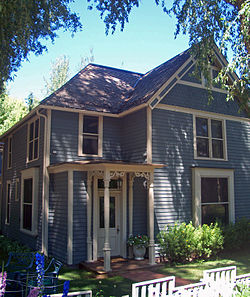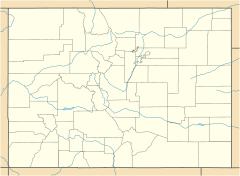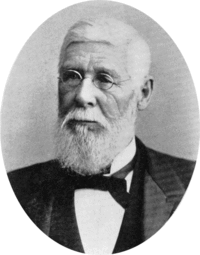- Davis Waite House
-
Davis Waite House
 West profile and south elevation, 2010Location within Colorado
West profile and south elevation, 2010Location within ColoradoLocation: Aspen, CO Coordinates: 39°11′39″N 106°49′26″W / 39.19417°N 106.82389°WCoordinates: 39°11′39″N 106°49′26″W / 39.19417°N 106.82389°W Built: 1888 Architectural style: Victorian Governing body: Private residence MPS: Historic Resources of Aspen NRHP Reference#: 87000160 Added to NRHP: March 6, 1987 The Davis Waite House is located on West Francis Street in Aspen, Colorado, United States. It is a wooden structure in Victorian architectural styles built during the 1880s. In 1987 it was listed on the National Register of Historic Places along with several other historic properties in the city.
Davis H. Waite, an early owner, was one of the founding publishers of The Aspen Daily Times. He was later elected governor of Colorado. After a single term he returned to Aspen. Later owners included Herbert Bayer, an Austrian architect extensively involved in the mid-20th century renovation of Aspen, and Robert Orville Anderson, an oil executive who was chairman of the Aspen Institute board.[1] The house has remained largely intact.
Contents
Building
The house is located at the northeast corner of West Francis and North Second streets in Aspen's residential West End. The surrounding neighborhood is well-developed with other houses, most of more modern construction. At the other end of the block, on the south side of the street, is the Bowles–Cooley House, also listed on the Register. The terrain is generally level, part of a very gentle drop from the slopes of Aspen Mountain to the south towards the Roaring Fork River to the north.
The building itself is a two-story[2] timber frame house on a stone foundation sided in clapboard with fish-scale shingle in the apex of the front gable. The cross-gabled west side projects slightly from just north of the main entrance, sheltered by a flat roof. There is a white picket fence at the street.[1] A small building is at the side.
Trim on the exterior consists of cream-painted wood. It serves as cornerboard, window surround, and cornice dividing the clapboard and shingle sidings. The porch's flat roof is supported by turned columns, with some wood tracery decorations at their tops. Paneled vergeboard in blue and cream is at the gable roofline.
Fenestration on the south (front) facade consists of one large one-over-one double-hung sash window in a slightly projecting bay with a pair of smaller one-over-one windows at the second story. In the gable field is an even smaller attic window, set off by cream courses at the sill and lintel. A smaller one-over-one is above the main entrance. On the west side are a similar treatment as the front on the south, with a single small window on the ground floor to the north between two smaller non-projecting one-over-ones.
History
The house was built in 1888 by a man named Francis Orange. Aspen at the time was a booming silver mining town, growing rapidly. An early miner's cabin on the property was converted into the outbuilding.[3]
One newcomer to the city was Davis Hanson Waite, a native of Jamestown, New York who had, on his way across the country, served in the Wisconsin[4] and Kansas state legislatures.[5] He bought the house and settled in, starting the Aspen Weekly Times, a newspaper still published today.[2] He remained involved in politics, and in 1892 was elected Governor of Colorado.[1]
After a single two-year term during which the Panic of 1893 and the ensuing repeal of the Sherman Silver Purchase Act ended Aspen's early prosperity, he was defeated for re-election. He returned to the house and spent his remaining years there. After his death in 1901, the house survived the early 20th-century period of the city's history known as the "quiet years", during which the city's population steadily declined and many buildings from the boom year were vacant for long periods, sometimes succumbing to fire and the effects of neglect and the severe winters at nearly 8,000 feet (2,400 m) above sea level in the Rocky Mountains.
In the middle of the century the city's fortunes began to change for the better. The Aspen Mountain ski resort was opened, bringing development and people back. Walter Paepcke, the Chicago industrialist who with his wife Elizabeth had financed the development of the ski resort and the Aspen Music Festival and School, sought to restore many of the old buildings that remained in order to make the city more attractive to visitors. They hired Bauhaus architect Herbert Bayer, who lived in the house while he was in Aspen, designing its current picket fence. Later, it was the home of Atlantic Richfield executive Robert Orville Anderson, who chaired the board of the Aspen Institute.[1]
See also
References
- ^ a b c d "West End Walking Tour". Heritage Aspen. http://www.heritageaspen.org/wewt.html. Retrieved August 2, 2011.
- ^ a b "Pitkin County". Colorado Office of Archaeology and Historic Preservation. http://www.historycolorado.org/oahp/pitkin-county. Retrieved August 2, 2011.
- ^ Norgren, Barbara (July 31, 1986). "Historic Resources of Aspen Multiple Resource Area". Colorado Office of Archaeology and Historic Preservation. p. 5. http://www.historycolorado.org/sites/default/files/files/OAHP/crforms_edumat/pdfs/635.pdf. Retrieved August 3, 2011.
- ^ Wisconsin Legislative Reference Bureau, Wisconsin Legislators 1848–1999PDF, September 1, 1999; retrieved August 3, 2011; p. 118
- ^ "Kansas Legislators Past and Present, Waa through Wat". State Library of Kansas. 2011. http://www.kslib.info/legislators/membw.html. Retrieved August 3, 2011.
U.S. National Register of Historic Places Topics Lists by states Alabama • Alaska • Arizona • Arkansas • California • Colorado • Connecticut • Delaware • Florida • Georgia • Hawaii • Idaho • Illinois • Indiana • Iowa • Kansas • Kentucky • Louisiana • Maine • Maryland • Massachusetts • Michigan • Minnesota • Mississippi • Missouri • Montana • Nebraska • Nevada • New Hampshire • New Jersey • New Mexico • New York • North Carolina • North Dakota • Ohio • Oklahoma • Oregon • Pennsylvania • Rhode Island • South Carolina • South Dakota • Tennessee • Texas • Utah • Vermont • Virginia • Washington • West Virginia • Wisconsin • WyomingLists by territories Lists by associated states Other  Category:National Register of Historic Places •
Category:National Register of Historic Places •  Portal:National Register of Historic PlacesCategories:
Portal:National Register of Historic PlacesCategories:- Houses on the National Register of Historic Places in Colorado
- Victorian architecture in Colorado
- Buildings and structures completed in 1888
- Aspen, Colorado
Wikimedia Foundation. 2010.


